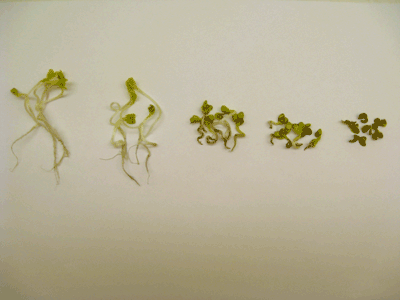Nanomutants?
Researchers at the National Institute of Standards and Technology (NIST) and the University of Massachusetts (UMass) Amherst have uncovered evidence that engineered nanoparticles can damage plant DNA. In a paper published in Environmental Science and Technology , Vol. 46, the team showed that, under laboratory conditions, cupric oxide nanoparticles are able to enter plant root cells and generate many mutagenic DNA base lesions. The nanoparticle concentrations used in this study were higher than those likely to be encountered by plants today under a typical soil exposure scenario.
Cupric oxide (CuO) is a strong conductor of electric current, a property enhanced at the nanoscale level, making CuO nanoparticles useful to semiconductor manufacturers. In bulk particle form, the compound has been used for many years as a pigment for coloring glass and ceramics, as a polish for optics, and as a catalyst in the manufacture of rayon. Oxidation caused by other metal oxides has been shown to induce DNA damage in certain organisms.
Led by NIST chemist Bryant C. Nelson, the team tested man-made particles between 1 and 100 nm in size on a human food crop, the radish (see Fig. 1 ), and two species of common ground covers used by grazing animals, perennial and annual ryegrass. Twice as many lesions were induced in radish plants exposed to nanoparticles as in those exposed to the larger particles. Additionally, the cellular uptake of copper from the nanoparticles was significantly greater.

Fig. 1: The growth of radish plants is impacted by exposure to cupric oxide bulk particles (BPs) and nanoparticles (NPs), with NPs showing the largest impact. In the plants seen here, the exposure concentrations from left to right are 0, 100 ppm BPs, 1,000-ppm BPs, 100-ppm NPs, and 1,000-ppm NPs. As can be seen, the 1,000-ppm NPs concentration resulted in severely stunted plants. (Photo: H. Wang, U.S. Environmental Protection Agency)
On the other hand, the DNA damage for the ryegrasses differed from that for the radish profiles, indicating that nanoparticle-induced DNA damage can depend on the plant species as well as nanoparticle concentration. However, CuO nanoparticles had a significant effect on growth in all three plant species tested, stunting root and shoot development.
In the study, the team exposed radishes and the two ryegrasses to CuO nanoparticles, larger sized CuO particles (bigger than 100 nm), and to simple copper ions. They then used gas chromatography–mass spectrometry (GC-MS) to detect the formation and accumulation of DNA base lesions, and inductively coupled plasma mass spectrometry (ICP-MS) to determine if and how much copper was taken up by the plants.
Nelson stated that, “To our knowledge, this is first evidence that there could be a ‘nano-based effect’ for cupric oxide in the environment, where size plays a role in the increased generation and accumulation of numerous mutagenic DNA lesions in plants.” The team plans to perform a similar study looking at the impact of titanium dioxide nanoparticles—such as those used in many sunscreens—on rice plants.
The research is part of ongoing work at NIST to help characterize nanomaterials’ potential environmental, health, and safety risks, and to develop methods for identifying and measuring them. For further information, contact Bryant C. Nelson,
, 301-975-2517.
Richard Comerford
Advertisement
Learn more about National Institute of Standards and Technology





